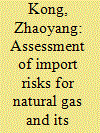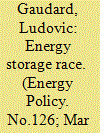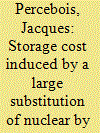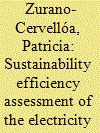|
|
|
Sort Order |
|
|
|
Items / Page
|
|
|
|
|
|
|
| Srl | Item |
| 1 |
ID:
137697


|
|
|
|
|
| Summary/Abstract |
The CA-TIMES optimization model of the California Energy System (v1.5) is used to understand how California can meet the 2050 targets for greenhouse gas (GHG) emissions (80% below 1990 levels). This model represents energy supply and demand sectors in California and simulates the technology and resource requirements needed to meet projected energy service demands. The model includes assumptions on policy constraints, as well as technology and resource costs and availability. Multiple scenarios are developed to analyze the changes and investments in low-carbon electricity generation, alternative fuels and advanced vehicles in transportation, resource utilization, and efficiency improvements across many sectors. Results show that major energy transformations are needed but that achieving the 80% reduction goal for California is possible at reasonable average carbon reduction cost ($9 to $124/tonne CO2e at 4% discount rate) relative to a baseline scenario. Availability of low-carbon resources such as nuclear power, carbon capture and sequestration (CCS), biofuels, wind and solar generation, and demand reduction all serve to lower the mitigation costs, but CCS is a key technology for achieving the lowest mitigation costs.
|
|
|
|
|
|
|
|
|
|
|
|
|
|
|
|
| 2 |
ID:
171377


|
|
|
|
|
| Summary/Abstract |
Saudi Arabia relies heavily on oil-based generation to meet its power needs within a geographically unbalanced pattern of natural demand and supply. Many initiatives are currently being assessed to reduce the high opportunity cost of burning oil for the country. This paper examines the cost and implication of a disruptive policy where Saudi Arabia imports liquefied natural gas (LNG). To determine the possible and optimal sources to procure LNG into Saudi Arabia we use and configure a partial equilibrium model, specified as a linear programming problem. Two import scenarios were tested: the first assumes an import terminal with a capacity of 5 million tonnes per annum (MTPA) and the other scenario assumes 22 MTPA. Results show that Saudi Arabia can import LNG for power generation at a discount to the opportunity cost of oil. Especially during the summer months, as Saudi Arabia's gas demand is counter-seasonal to major importing regions it leads to even more interesting market pricing conditions. It also shows a small difference in landed cost of LNG between the two scenarios which implies the global LNG market can accommodate relatively large demand from Saudi Arabia without distorting significantly the global market pricing mechanism.
|
|
|
|
|
|
|
|
|
|
|
|
|
|
|
|
| 3 |
ID:
166302


|
|
|
|
|
| Summary/Abstract |
China's growing dependence on foreign natural gas has garnered increased attention to import risks and exposure. The purpose of this study is to serve as a vital guide in formulating an energy policy framework that aims at assessing and mitigating the impacts of natural gas import risks (NGIR). First, the paper constructs a NGIR evaluation framework with full consideration of resource risk, political risk, transport risk, price volatility risk, purchasing power risk and dependence risk. The relative weight of various risk factors is also identified for importing gas from different sources. Building on this, we use a linear programming model to optimize China's gas import sources based on the minimization of import risks. The results show that China's NGIR exhibited increasing trends in 2010–2014, with variation in the largest risk factors by national gas supplier. For Turkmenistan and Indonesia, the greatest risk is dependence; for Qatar, price volatility risk; for Yemen, Australia and Uzbekistan, resource risk; and for Malaysia, purchasing power risk. Along with other policy recommendations, our optimization results indicate that increasing the proportion of Chinese gas imports from potential suppliers, such as Russia and the United States, is an effective approach to reduce NGIR.
|
|
|
|
|
|
|
|
|
|
|
|
|
|
|
|
| 4 |
ID:
125652


|
|
|
|
|
| Publication |
2013.
|
| Summary/Abstract |
Environmental constraints imposed on hydropower operation are becoming increasingly restrictive. These constraints may reduce the operational flexibility of a hydro plant and therefore its revenue. The objective of this paper is to assess the economic impact of minimum environmental flows and maximum ramping rates on the annual operation of a hydropower plant. For this purpose, a revenue-driven annual optimization model based on discrete dynamic programming and mixed integer linear programming is used. The model considers hourly water inflows and energy prices, limits on reservoir level and water discharge, power generation dependence on the available head, wear and tear costs of hydro units caused by power variations, start-up and shut-down costs of hydro units, and the above-mentioned environmental constraints. In order to show the applicability of the proposed methodology, it is used in a real hydropower plant under five different water year types and 56 distinct combinations of the considered environmental constraints. The results indicate that the revenues of the hydropower plant are very sensitive to the presence and magnitudes of these constraints. Annual losses increase quadratically as a function of the maximum ramping rates and almost linearly as a function of the minimum environmental flows.
|
|
|
|
|
|
|
|
|
|
|
|
|
|
|
|
| 5 |
ID:
109996


|
|
|
|
|
| Publication |
2011.
|
| Summary/Abstract |
The authors examine an automated control system for preparing and conducting military operations; and identify ways they consider essential for improving control efficiency.
|
|
|
|
|
|
|
|
|
|
|
|
|
|
|
|
| 6 |
ID:
112906


|
|
|
|
|
| Publication |
2012.
|
| Summary/Abstract |
Local authorities often rely upon urban energy and carbon modelling tools to develop mitigation policies and strategies that will deliver reductions in greenhouse gas emissions. In this paper the UK example of Newcastle-upon-Tyne is used to critique current practice, noting that important features of urban energy systems are often omitted by bottom-up tools including interactions between technologies, spatial disaggregation of demand, and the ability to pursue over-arching policy goals like cost minimization. An alternative optimization-based approach is then described and applied to the Newcastle case, at the scale of both the whole city and the South Heaton district, and using Monte Carlo techniques to address policy uncertainty. The results show that this new method can help policy makers draw more robust policy conclusions, sensitive to spatial variations in energy demand and capturing the interactions between developments in the national energy system and local policy options. Further work should focus on improving our understanding of local building stocks and energy demands so as to better assess the potential of new technologies and policies.
|
|
|
|
|
|
|
|
|
|
|
|
|
|
|
|
| 7 |
ID:
109388


|
|
|
|
|
| Publication |
2011.
|
| Summary/Abstract |
Costs and benefits of building energy efficiency are estimated as a means of reducing greenhouse gas emissions in Pittsburgh, PA and Austin, TX. The analysis includes electricity and natural gas consumption, covering 75% of building energy consumption in Pittsburgh and 85% in Austin. Two policy objectives were evaluated: maximize GHG reductions given initial budget constraints or maximize social savings given target GHG reductions. This approach evaluates the trade-offs between three primary and often conflicting program design parameters: initial capital constraints, social savings, and GHG reductions. Results suggest uncertainty in local stocks, demands, and efficiency significantly impacts anticipated outcomes. Annual GHG reductions of 1 ton CO2 eq/capita/yr in Pittsburgh could cost near nothing or over $20 per capita annually. Capital-constrained policies generate slightly less social savings (a present value of a few hundred dollars per capita) than policies that maximize social savings. However, sectors and end uses targeted for intervention vary depending on policy objectives and constraints. Optimal efficiency investment strategies for some end uses vary significantly (in excess of 100%) between Pittsburgh and Austin, suggesting that resources and guidance conducted at the national scale may mislead state and local decision-makers. Results are used to provide recommendations for efficiency program administrators.
|
|
|
|
|
|
|
|
|
|
|
|
|
|
|
|
| 8 |
ID:
163528


|
|
|
|
|
| Summary/Abstract |
The rise of renewable energies has brought a new challenge in terms of the management of their intermittency. Pumped-storage hydroelectricity has served as the large-scale solution to the intermittency problem. However, flawed European spot markets and innovation are jeopardizing the future of this technology. This paper: 1) estimates historic revenues of 96 energy storage installations on 17 European electricity spot markets, 2) assesses how arbitrage revenue has evolved, and 3) compares the present value of new energy technologies (compressed air, batteries) with pumped-storage in energy-only markets. Results show that market openings to competition had led to revenue drops and convergence: all markets generate low income. Based on the findings: 1) energy storage requires revenue from other markets than spot ones 2) compressed air energy storage is competitive with pumped-storage, and 3) markets value daily pumped-storage installations rather than seasonal, where this technology keeps a technical comparative advantage. It means the current best pumped-storage installation design could not be the long-term one. We also highlight that further research should investigate if interconnection, a natural monopoly, competes with energy storage, which is open to competition.
|
|
|
|
|
|
|
|
|
|
|
|
|
|
|
|
| 9 |
ID:
149602


|
|
|
|
|
| Summary/Abstract |
This article presents a novel application of an inspection game to find optimally efficient nuclear safeguard strategies. It describes a methodology that allocates resources at and across nuclear fuel cycle facilities for a cost-constrained inspectorate seeking to detect a state-facilitated diversion or misuse. The methodology couples a simultaneous-play game theoretic solver with a probabilistic model for simulating state violation scenarios at a gas centrifuge enrichment plant. The simulation model features a suite of defender options based on current International Atomic Energy Agency practices and an analogous menu of attacker proliferation pathway options. The simulation informs the game theoretic solver by calculating the detection probability for a given inspector-proliferator strategy pair. To generate a scenario payoff, it weights the detection probability by the quantity and quality of material obtained. Using a modified fictitious play algorithm, the game iteratively calls the simulation model until Nash equilibrium is reached and outputs the optimal inspection and proliferation strategies. The value the attacker places on material quantity and quality is varied to generate results representative of states with different capabilities and goals. Sample model results are shown to illustrate the sensitivity of defender and attacker strategy to attacker characteristics.
|
|
|
|
|
|
|
|
|
|
|
|
|
|
|
|
| 10 |
ID:
177474


|
|
|
|
|
| Summary/Abstract |
This paper investigates how to implement residential dynamic taxation in Denmark. To this end, it proposes three dynamic schemes that can be implemented by the Danish government. In particular, the paper studies one Ad-valorem and two different per-unit tax schemes, which respectively depend on electricity consumption and CO emissions. A second contribution of the paper is to perform a holistic impact assessment based on six different categories, which decision makers can utilize to evaluate taxation schemes. These are: CO emissions saved; the social cost of CO savings; revenue neutrality; the composition of the production mix; transparency and predictability of taxation schemes; and how much consumption can be shifted. Based on the findings, a recommendation directed at Danish decision makers in the energy sector is presented. Results stand in contrast to earlier findings in the literature and suggest that a per-unit (excise) dynamic taxation scheme that depends on the level of consumption is preferred over a per-unit taxation scheme that depends on CO emissions or an Ad-valorem tax on the retail electricity price. This assessment is based on the considerations that the preferred scheme: (1) incentivizes greater demand-side flexibility, (2) reduces CO emissions more efficiently, (3) depends on a predictable random variable, i.e. electricity consumption.
|
|
|
|
|
|
|
|
|
|
|
|
|
|
|
|
| 11 |
ID:
149969


|
|
|
|
|
| Summary/Abstract |
Demand Response allows for the management of demand side resources in real-time; i.e. shifting electricity demand according to fluctuating supply. When integrated into electricity markets, Demand Response can be used for load shifting and as a replacement for both control reserve and balancing energy. These three usage scenarios are compared based on historic German data from 2011 to determine that load shifting provides the highest benefit: its annual financial savings accumulate to €3.110 M for both households and the service sector. This equals to relative savings of 2.83% compared to a scenario without load shifting. To improve Demand Response integration, the proposed model suggests policy implications: reducing bid sizes, delivery periods and the time-lag between market transactions and delivery dates in electricity markets.
|
|
|
|
|
|
|
|
|
|
|
|
|
|
|
|
| 12 |
ID:
167730


|
|
|
|
|
| Summary/Abstract |
The paper analyzes scientific grounds for managing logistic processes within the system of logistical support of the Collective Rapid Deployment Forces, and examines the methodology that helps form an optimum makeup of the logistical system on the basis of own and enlisted resources.
|
|
|
|
|
|
|
|
|
|
|
|
|
|
|
|
| 13 |
ID:
092605


|
|
|
|
|
| Publication |
2009.
|
| Summary/Abstract |
China's Strategic Petroleum Reserve (SPR) is currently being prepared. But how large the optimal stockpile size for China should be, what the best acquisition strategies are, how to release the reserve if a disruption occurs, and other related issues still need to be studied in detail. In this paper, we develop a stochastic dynamic programming model based on a total potential cost function of establishing SPRs to evaluate the optimal SPR policy for China. Using this model, empirical results are presented for the optimal size of China's SPR and the best acquisition and drawdown strategies for a few specific cases. The results show that with comprehensive consideration, the optimal SPR size for China is around 320 million barrels. This size is equivalent to about 90 days of net oil import amount in 2006 and should be reached in the year 2017, three years earlier than the national goal, which implies that the need for China to fill the SPR is probably more pressing; the best stockpile release action in a disruption is related to the disruption levels and expected continuation probabilities. The information provided by the results will be useful for decision makers.
|
|
|
|
|
|
|
|
|
|
|
|
|
|
|
|
| 14 |
ID:
122714


|
|
|
|
|
| Publication |
2013.
|
| Summary/Abstract |
This paper presents a brief review of the conventional and renewable energy statuses, in Lebanon, as well as of the principal problems facing the electricity of Lebanon Company (EDL). In addition, an analytical-critical review of the latest three official Lebanese electricity plans is presented. Furthermore, two future electricity generation plan-scenarios for Lebanon are investigated, where multi variables are examined, namely: cost, environment and tariff. First, an economical-environmental optimization is carried out, where two reasonable scenarios are introduced based on the fuel source of CCGT power plants. Results revealed that the investment in wind energy and natural gas for power production should be a main concern in the future. Second, an optimization of the average electricity tariff for each of the two investigated generation scenarios is studied, where three different approaches are illustrated. Results confirm that all tariff plans are acceptable and convincing, and that the use of natural gas in CCGT plants is always preferred against gasoil. Moreover, the optimized average tariff is maximally a double of the current EDL average tariff, which is very convincing compared with the actual cost of electricity for the current Lebanese electricity sector.
|
|
|
|
|
|
|
|
|
|
|
|
|
|
|
|
| 15 |
ID:
103455


|
|
|
|
|
| Publication |
2011.
|
| Summary/Abstract |
Electricity storage is considered as a valuable source of flexibility with applications covering the whole electricity value chain. Most of the existing evaluation methods for electricity storage are conceived for one specific use of the storage, which often leads to the conclusion that the investment on storage does not pay off. However, the value of storage cannot be properly estimated without taking into account the possibility of aggregating the services that storage can offer to different actors. This paper proposes a new business model that allows aggregating multiple revenue streams of electricity storage in a systematic way. The model consists in coordinating a series of auctions in which the right to utilize the storage unit is auctioned upon different time horizons. In the mean time, non-conflicting usage of storage by the actors in these different auctions is ensured. The functioning of the model is demonstrated by a case study. The results show that a storage unit can achieve higher return on investment in the manner proposed in the business model.
|
|
|
|
|
|
|
|
|
|
|
|
|
|
|
|
| 16 |
ID:
111446


|
|
|
|
|
| Publication |
2012.
|
| Summary/Abstract |
A Response Surface-Based Wind Farm Cost (RS-WFC) model is developed for the engineering planning of wind farms. The RS-WFC model is developed using Extended Radial Basis Functions (E-RBF) for onshore wind farms in the U.S. This model is then used to explore the influences of different design and economic parameters, including number of turbines, rotor diameter and labor cost, on the cost of a wind farm. The RS-WFC model is composed of three components that estimate the effects of engineering and economic factors on (i) the installation cost, (ii) the annual Operation and Maintenance (O&M) cost, and (iii) the total annual cost of a wind farm. The accuracy of the cost model is favorably established through comparison with pertinent commercial data. The final RS-WFC model provided interesting insights into cost variation with respect to critical engineering and economic parameters. In addition, a newly developed analytical wind farm engineering model is used to determine the power generated by the farm, and the subsequent Cost of Energy (COE). This COE is optimized for a unidirectional uniform "incoming wind speed" scenario using Particle Swarm Optimization (PSO). We found that the COE could be appreciably minimized through layout optimization, thereby yielding significant cost savings.
|
|
|
|
|
|
|
|
|
|
|
|
|
|
|
|
| 17 |
ID:
169888


|
|
|
|
|
| Summary/Abstract |
This paper explains some adverse effects due to a massive injection of renewables when electricity storage is not available, such as a fall of electricity prices on the spot market or a crowding-out effect for nuclear power stations due to the merit order logic. From the French experience, it presents a model that calculates the additional cost of electricity production when the share of nuclear generation is reduced to 50% instead of 72% today and when, in compensation, renewable energy (wind and solar) is stored either by batteries or by power-to-gas. The simulations minimize the cost of the energy mix by optimizing the electricity storage mix: batteries (daily storage) and Power-to-Gas/Gas-to-Power (seasonal storage). The paper also estimates the negative externalities of intermittent renewable energies that lie in between 44 and 107 €/MWh. It also examines the impact on the merit order when those negative externalities are accounted for. Finally, the simulation results lead us to provide some recommendations concerning R&D electricity storage policy and electricity mix fine tuning.
|
|
|
|
|
|
|
|
|
|
|
|
|
|
|
|
| 18 |
ID:
169738


|
|
|
|
|
| Summary/Abstract |
Assessing the sustainability level of the power sector can aid the transition towards a sustainable energy system. In this contribution, we propose a novel approach to compare and optimize electricity mixes according to sustainability criteria and apply it to the 28 EU members. Our method combines life cycle assessment, data envelopment analysis (DEA) and rigorous mathematical programming tools in three main steps. Firstly, DEA is applied to assess the efficiency level of electricity mixes of EU member countries considering the three dimensions of sustainability. Then, electricity portfolios of inefficient countries are optimized by solving a model that seeks to attain the targets provided by DEA while simultaneously considering the technical aspects governing electricity generation. This model, which constitutes the cornerstone of our approach, complements standard DEA by ensuring realistic and meaningful targets. In the third step, we evaluate the electricity portfolios optimized previously by running DEA again. Our results suggest that energy policies in the EU should favor the deployment of hydropower, wind and solar, while simultaneously displacing non-renewable sources and bioenergy. The deployment of carbon capture and storage is also a potential alternative that could be incentivized via policies worded in terms of carbon intensity targets.
|
|
|
|
|
|
|
|
|
|
|
|
|
|
|
|
| 19 |
ID:
171467


|
|
|
|
|
| Summary/Abstract |
Sustainable energy requires renewable energy sources to reduce reliance on fossil fuels. As a renewable energy source, first-generation bioethanol has been produced from corn. However, the production of such a biofuel increases corn-based food prices resulting in serious food versus fuel debates. Financial incentives would motivate first-generation bioethanol producers switching to second-generation bioethanol production. This study investigates the effects of two financial incentives (incentive payments and emissions penalties) motivating first-generation bioethanol producers to use second-generation biomass. These financial incentives are integrated into linear programming models to maximize the profit of the bioethanol supply chains in the state of North Dakota. Numerical results indicate that first-generation bioethanol production is more efficient than the second-generation bioethanol. Hence, the social value of using corn as a source for food instead of fuel must be at least $2.38/bushel. Furthermore, to switch from the first to the second-generation biofuel production, bioethanol producers must either receive at least an incentive payment of $0.8495 per gallon of second-generation bioethanol or pay at least a penalty of $3.2573 per Kg CO2e emitted due to first-generation bioethanol production. The results of this study support policymaker decisions in developing incentive programs to promote sustainable second-generation bioethanol in the US.
|
|
|
|
|
|
|
|
|
|
|
|
|
|
|
|
| 20 |
ID:
040786


|
|
|
|
|
| Publication |
New Jersey, Prentice-Hall, Inc., 1969.
|
| Description |
xvi, 472p.Hbk
|
|
|
|
|
|
|
|
|
|
|
|
Copies: C:1/I:0,R:0,Q:0
Circulation
| Accession# | Call# | Current Location | Status | Policy | Location |
| 003563 | 658.4032/DEU 003563 | Main | On Shelf | General | |
|
|
|
|
|
|
|
|
|